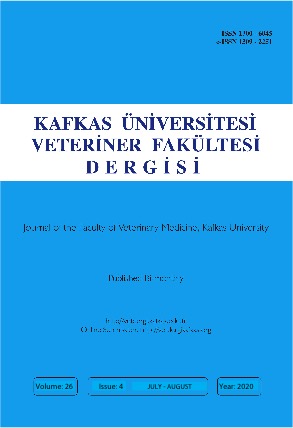
This journal is licensed under a Creative Commons Attribution-NonCommercial 4.0 International License
Kafkas Üniversitesi Veteriner Fakültesi Dergisi
2020 , Vol 26 , Issue 4
The Effect of Mixture of Rapeseed Meal, White Lupin Seed, and Pea Seed in Rabbit Diets on Performance Indicators and Fatty Acid Profile of Meat and Fat
1Department of Small Livestock Breeding, National Research Institute of Animal Production, Balice, 32-083 Kraków, POLAND2Department of Fur-bearing Animal Breeding and Game Management, Faculty of Animal Bioengineering, University of Warmia and Mazury, 10-719 Olsztyn, POLAND
3Department of Animal Science, Veterinary Academy of Lithuanian University of Health Sciences, LT-47181, Kaunas, LITHUANIA DOI : 10.9775/kvfd.2019.23222 Quality of rabbit"s carcasses is largely determined by the composition of the lipid fraction. The objective of this study was to determine the effect of partial or complete substitution of soybean meal with a combination of rapeseed meal, white lupin seed and pea seed on the production results and fatty acid profile of meat and fat in rabbits. Ninety New Zealand White rabbits were divided into three feeding groups, 30 in each group: Control - C (mean protein source - 15% soybean meal in the diet), Experimental 1 - E1 (7.5% soybean meal, 5% rapeseed meal, 4% white lupin seed, 3% pea seed) and Experimental 2 - E2 (0% soybean meal, 10% rapeseed meal, 8% white lupin seed, 6% pea seed). No significant differences were determined in the final body weights of rabbits. Feed efficiency was better in both of the E groups than in group C. Dressing percentage was higher in group E2 than in group C. Also, protein content in thigh muscle was higher in groups E than in group C. As the dietary proportion of soybean decreased, the proportion of SFA in meat and in perirenal fat decreased, and that of PUFA increased. The obtained results indicate that soybean meal may be successfully replaced in rabbit diets by the combination of rapeseed meal, white lupin seed, and pea seed. Keywords : Brassicaceae, Fabaceae, Fatty acid profile, Growth performance, Meat composition, Rabbit feeding










